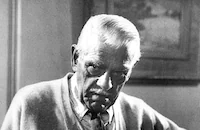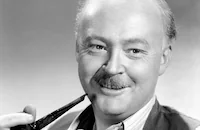The Man They Could Not Hang

Brief Synopsis
Cast & Crew
Nick Grinde
Boris Karloff
Lorna Gray
Robert Wilcox
Roger Pryor
Don Beddoe
Film Details
Technical Specs

Synopsis
Obsessed with bringing the dead back to life, Dr. Henryk Savaard perfects a mechanical device that suspends and restores life at will. The doctor is working on his first patient, a medical student who has volunteered for the experiment, when the police, alerted by the student's sweetheart, break into the lab and refuse to allow the doctor to bring his human guinea pig back to life. Convicted and sentenced to hang for murder, the doctor vows revenge on the judge, jury and district attorney. After the hanging, the doctor's trusted assistant claims his lifeless body and, using the mechanical device perfected by Savaard, brings him back to life. Foresaking science for revenge, Savaard lures his persecutors one by one to his house and murders them. After the death of the sixth juror, reporter "Scoop" Foley deduces that the killings are related to the doctor's trial, and he goes to the Savaard house, where he finds the surviving members of the trial imprisoned by the vengeance-crazed doctor. Savaard is working on his ninth victim when his daughter Janet interrupts his plans. In the confusion, Janet is electrocuted and Savaard mortally wounded. Summoning the strength to apply his lifesaving technique to his own daughter, Savaard then destroys the apparatus and dies of his injuries, taking the secret of perpetual life to his grave.

Director
Nick Grinde
Cast

Boris Karloff
Lorna Gray
Robert Wilcox

Roger Pryor

Don Beddoe

Ann Doran
Joseph De Stefani
Charles Trowbridge

Byron Foulger
Dick Curtis

James Craig
John Tyrrell
Ian Maclaren
Harlan Briggs
George Anderson
Stanley Brown
Flo Campbell
John Dilson

Robert Sterling
Franklin Parker
Frank Jaquet
Charles Miller
Cyril Thornton
Sam Ash
Larry Lund
Bill Lally
Stanley Blystone

Walter Sande
Charles Mcavoy
Crew

Videos
Movie Clip



Film Details
Technical Specs

Articles
The Man They Could Not Hang
Karloff plays Dr. Henryk Savaard, who is preparing to resuscitate a student volunteer from an experiment in suspended animation, when his nurse, the volunteer's girlfriend, loses her nerve and runs for the police. Once the authorities arrive, they refuse to let the doctor bring the man back to life. Instead, he is taken to prison, tried and sentenced to death by hanging. Savaard has arranged for his trusty assistant to take custody of his body post mortem for an "interesting experiment", which the authorities don't seem to find peculiar. As the film's title implies, Dr. Savaard returns, though in a much darker mood than the one in which he departed.
The storyline of The Man They Could Not Hang was inspired by the real-life experiments, several years prior, of a biochemist named Robert Cornish, who brought dogs back to life after giving them nitrogen gas. An unfortunate side effect of the process he used, however, is that the dog wasn't quite the same after being revived. With echoes of Pet Sematary (1989) which proved that 'sometimes dead is better', Cornish's dog, Lazarus IV, was put to death a final time after having trouble walking, eating and remembering his earlier training. Similarly, Dr. Savaard isn't the same person he was prior to death. Minus his higher humanitarian goals, he is now bent on retribution and gathers the jurors and others responsible for his conviction to his house for a gruesome finish.
During the '30s, between the experiments of Cornish and the glass heart developed by aviator Charles Lindbergh and French surgeon Alexis Carrel, public interest was high in the possibilities of reanimation, pacemakers and other electrical devices to affect heart rhythm. Hollywood followed suit, and in addition to Frankenstein (1931), a number of films focused on the downside of experiments with life and death which were better left to divine powers. Yet The Man They Could Not Hang is surprising in that it also contains an indictment of small-mindedness for those who scoffed at and feared the doctor's scientific advances, delivered in a well-written address to the jury, given by Savaard.
In a rare-for-its-time presentation of healthy agnosticism, Savaard converses with a minister just before his hanging: "Is it strange that I should have no fear of dying? Well, I've lived for so long questioning the unknown that this plunge into its depths is only the last and, perhaps, the greatest of my experiments." The minister asks, "Have you no faith?" Savaard replies, "As a scientist, I'm afraid I'm a professional skeptic who doubts everything, even the certainties." In 1939, the Production Code included three provisions regarding reverence for religion; characters espousing uncertainty about the hereafter were not frequent-especially those as articulate as Dr. Savaard.
With the series of Karloff laboratory films, Columbia hit on a successful formula and stuck with it, much to Karloff's chagrin. In the book Boris Karloff, by Scott Allen Nollen, the actor remembers: "The scriptwriters had the insane scientist transplant brains, hearts, lungs and other vital organs. The cycle ended when they ran out of parts of anatomy that could be photographed decently."
Producer: Wallace MacDonald
Director: Nick Grinde
Screenplay: Karl Brown; George Wallace Sayre (story); Leslie T. White (story)
Cinematography: Benjamin H. Kline
Film Editing: William A. Lyon
Cast: Boris Karloff (Dr. Henryk Savaard), Lorna Gray (Janet Savaard), Robert Wilcox (Scoop Foley), Roger Pryor (Dist. Atty. Drake), Don Beddoe (Police Lt. Shane), Ann Doran (Betty Crawford), Joe De Stefani (Dr. Stoddard), Charles Trowbridge (Judge Bowman), Byron Foulger (Lang), Dick Curtis (Clifford Kearney), James Craig (Watkins), John Tyrrell (Sutton)
BW-65m.
by Emily Soares














